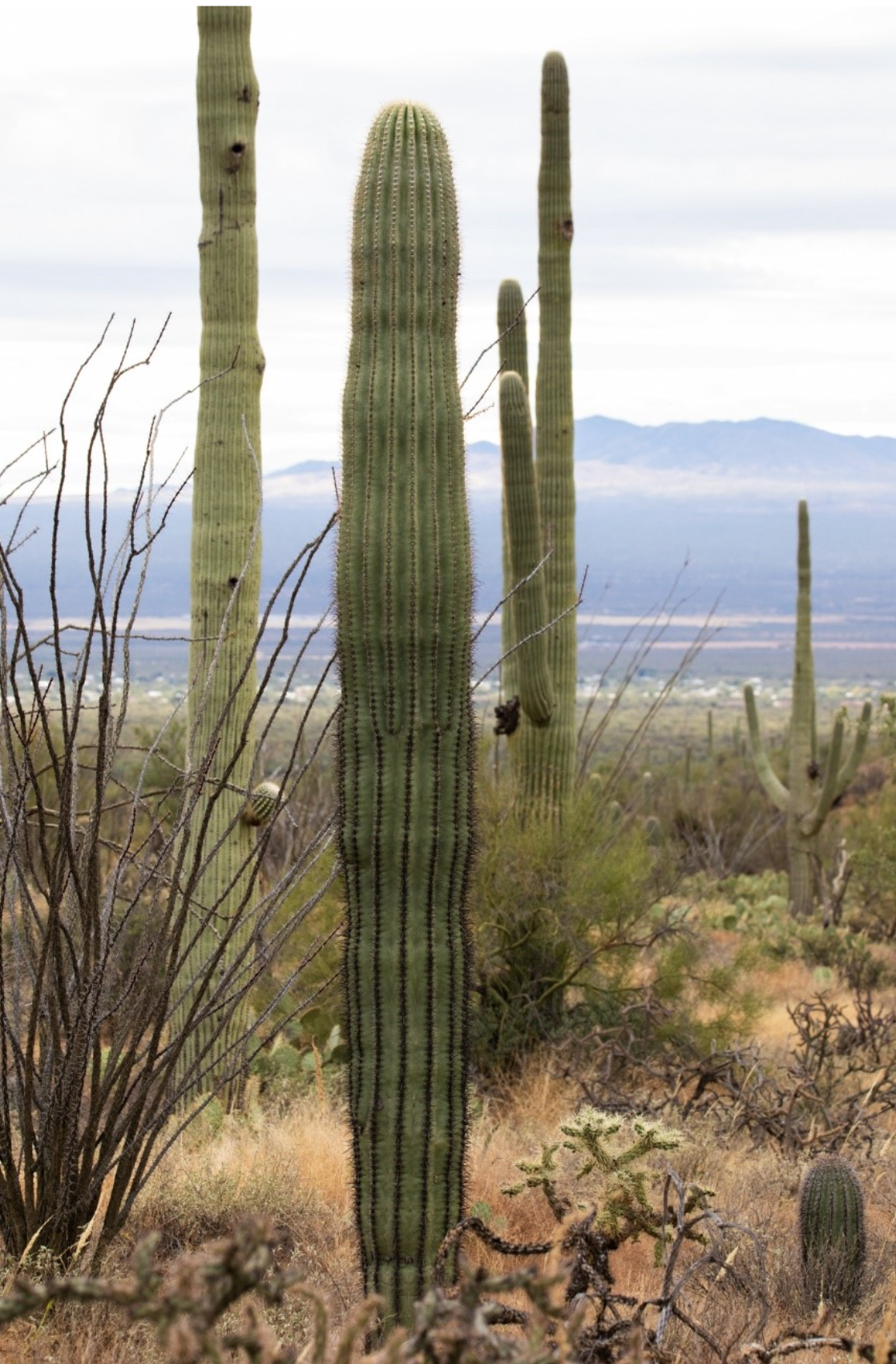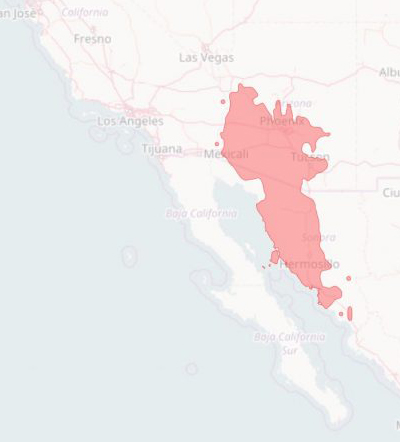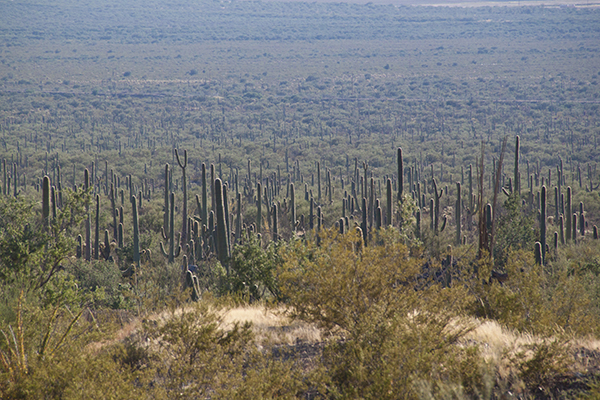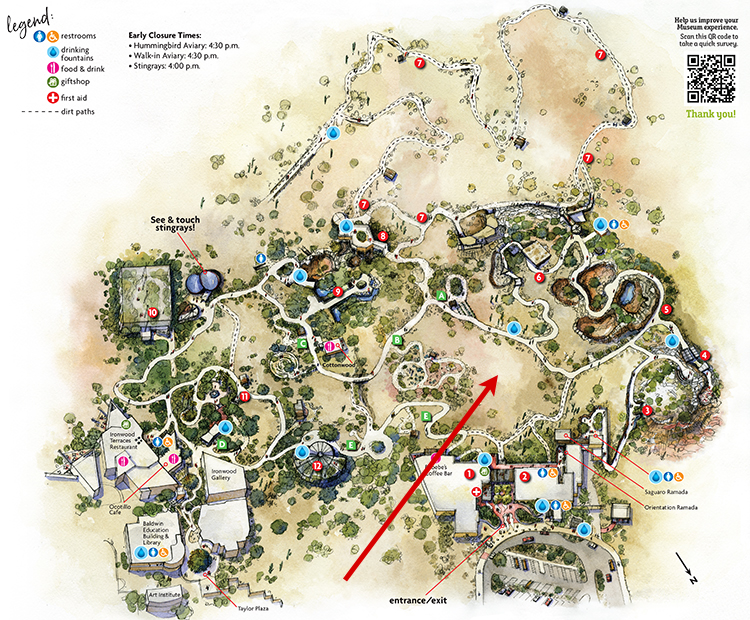Saguaro Cactus

About
The saguaro is an icon of the Sonoran Desert region! This impressive plant is the largest cactus in the United States, growing 10 to 40 feet or even 50 feet tall. (Picture a three-story building!) Though they’re about 30 inches across, their root systems can extend as far as 100 feet (or as wide as three school buses parked in a line). These majestic cactuses can live up to 200 years. They develop their upturned arms (as many as 24!) at 75 to 100 years of age. Some never grow arms and are called spears. Scattered across the landscape, saguaros are such a dominant feature of their habitats that they have come to represent the entire Southwest in popular culture and media, but they grow only in the Sonoran Desert.
Adaptations
For nourishment and to defend themselves from drought, saguaros absorb and store rainwater. Their waxy exteriors keep the water contained and support efficient water use. Their sharp spines, which can be as long as 3 inches, provide protection from thirsty animals as well as from the sun.
Challenges
- One of the biggest threats to saguaros the dense growth of invasive species, such as buffelgrass, which uses up available water and makes the area more susceptible to fire. Read more about buffelgrass and ways in which you can help save saguaros at www.buffelgrass.org!
- Rising temperatures brought on by climate change can create drought conditions that kill off even well-established saguaros.

Habitat and Range
This cactus is found exclusively in the Sonoran Desert. The most important factors for growth are water and temperature. If the elevation is too high, the cold weather and frost can kill the saguaro. It is thought that the saguaro obtains most of its moisture during the summer rainy season.
Saguaros grow in southern Arizona, the Whipple Mountains and Imperial County of California, and western Sonora in Mexico. They cannot survive in cold climates.

Arizona-Sonora Desert Museum / Liz Kemp
Family Life
Because many other species rely on them for sustenance and shelter, saguaros are a keystone species, a foundation of the ecosystem in which they grow. Birds, bats, tortoises, javelinas, coyotes, and others feed on their sweet, red fruit. Some birds carve holes high up as shelters for their nests. A saguaro boot forms as the inside of these cavities harden, and when vacated by the original residents they become home to other birds that move in. Humans, too, benefit from the saguaro. Many people, including the Tohono O’odham, Pima, and Seri, use every part of the cactus, eating or making syrup from the fleshy fruit, repurposing the boots as water containers, and using the wood-like ribs as building materials for roofs, fences, and furniture after the cactus dies and decays. The saguaro skeleton also makes a great home and resting spot for desert critters.
From April through June, white flowers with thick, waxy petals grow at the crown of the saguaro, and open at night when bats pollinate the flowers. Honey bees and other insects, white-winged doves, and some hummingbirds pollinate them the following morning. By June and early July, the red fruit mature and ripen. The small seeds germinate about a year later, but due to dryness and being a food source for animals, only 1% successfully sprout.
Glossary
- Keystone species:
- A species that provides food and habitat to a large number of other species.
- Ecosystem:
- A community or group of living organisms that inhabit and interact with each other in a specific environment.
- Spear:
- A saguaro without arms.
- Saguaro boot:
- Named for its shape, the container formed by the hard tissue that forms along the inside of nesting cavities carved out by birds.
- Drought:
- A prolonged period of dryness and low rainfall. This leads to a shortage of water.
Fun Facts
- The saguaro is a keystone species, integral to the activities and life cycles of many other species around it.
- The Tohono O'odham regard saguaros as sacred — embodiments of their ancestors — and treat them with great respect as members of their community.
- You'll often find a saguaro growing underneath or through a nurse plant, such as a palo verde or creosote, which protects a small saguaro from the elements and greatly improves its chances of survival.
Conservation
- The saguaro is not currently listed as threatened or endangered.
- Saguaros are a protected species; it’s illegal to harm or vandalize them and a permit is required to move or destroy them for building or other purposes.
At The Museum
View on Map

Saguaros can be seen growing throughout the Museum grounds. See a crested saguaro at the front entrance to the Museum!
Accessibility: Rough terrain & wheelchair accessible.










